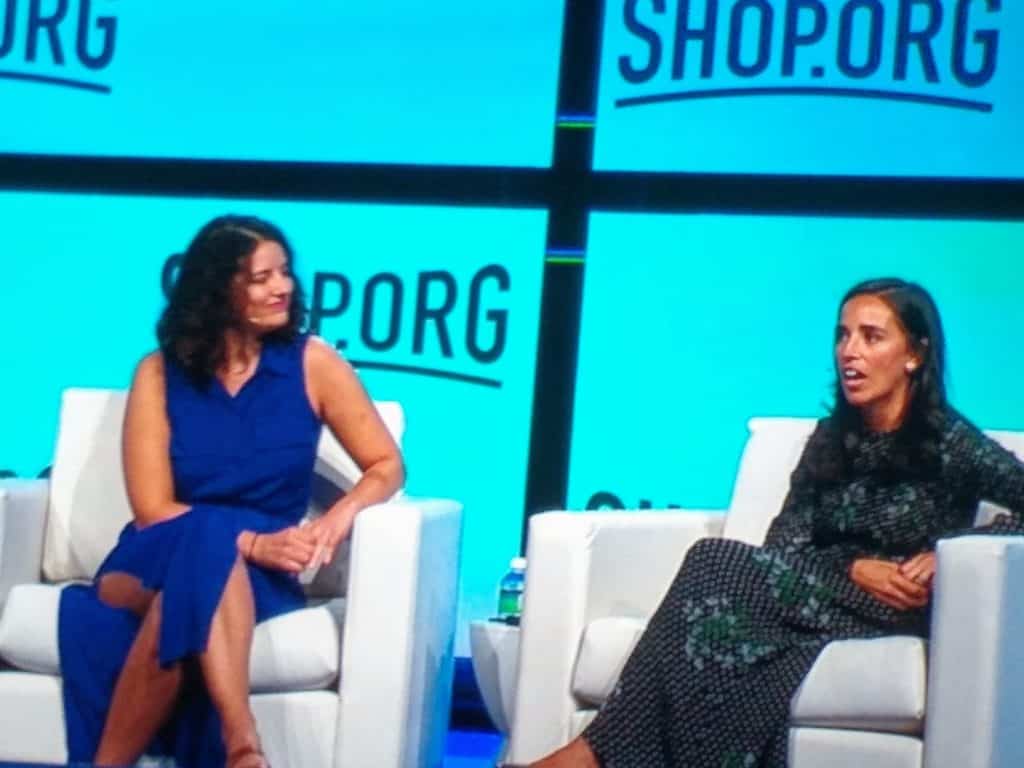You have customers. But do you have online advocates willing to create content and engage other customers and potential customers about the benefits of using your products, as well as pitch in ideas for creating new ones?
One powerful, although potentially risky, way to reach and engage consumers is to cultivate a community of customers to interact and share ideas. Retailers can do this on social media, via online review logs or other tools to allow customers and potential customers to interact.

Giphy’s Caroline Huber (left) and Ali Weiss of Glossier.
At the National Retail Federation’s Shop.org conference in Las Vegas on Thursday, representatives of two brands—direct-to-consumer beauty brand Glossier Inc. and Giphy, a web service that allows users to search for and share short, silent looping videos called GIFs—discussed why retailers should form communities and offered advice about how to do it right.
At Glossier, having an ongoing conversation with consumers is at the heart of what the company is about, says Glosssier’s Ali Weiss, senior vice president of marketing.
“Our purpose in the world is to give people a voice… so that they can feel like individuals, able to express their individuality,” and personal sense of style, she says.
That, Weiss says, gives customers a sense of ownership and a deeper connection to the brand. It also gives Glossier important feedback and data it can use when it creates new products.
While there are people who have found ways to make a living as professional online influencers, she says most members of Glossier’s online community are motivated by the opportunity to get exposure, create content and interact with others.
On its website, the company operates an interactive blog, called Into the Gloss, on which consumers can interact by posting comments using Disqus, a blog comment hosting service for websites and online communities. Glossier also maintains a robust social media presence on Instagram, Pinterest, Facebook, Twitter and YouTube.
Glossier’s Instagram account provides a good example of the retailer’s online community at work. A Sept. 13 post by Glossier about the company’s Solution skin-care product garnered more than 20,000 “likes” and 112 comments in less than 24 hours. The commenters not only provided their impressions about the product, they asked questions of other users and offered their own skin-care advice.
Weiss says it’s inevitable that a customer will leave negative comments. But, if unhappy community members are dealt with quickly, the situation can often be turned around and become positive for the brand.
Weiss says research shows that four out of five customers will alter a purchase decision based on online reviews. But the flip side is that consumers also trust online community members as much as they do friends and family. So, positive testimonials can be very powerful as well.
Earlier this year, Glossier president and chief operating officer Henry Davis told Internet Retailer that 80% of the retailer’s sales stem from some combination of word-of-mouth recommendations, blog, Glossier.com’s other content and social media.
“It’s definitely a risk,” says Caroline Huber, Giphy’s vice president of product. With more than 300 million users, Giphy can’t predict what will be posted. But the company has taken precautions, she says, such as developing image-detection technology to look for images that might be problematic.
Huber says the need to monitor content is a growing concern for all platforms that use user-generated content—and Giphy is no different. As they create online communities, brands must be prepared to police them. “Anybody working in content definitely has to be prepared to spend time and resources toward actually reviewing content,” Huber says.
Like Glossier, Giphy also has a presence on big social media sites, including Facebook, Twitter and Instagram, in addition to its own interactive website, which makes sense because the GIFs and memes posted on the site are made to be shared.
The content-screening process, Huber says, has to consider how content that seems fine to the creator might offend other people, which can be tricky. “First of all, everybody has different values,” she says, so what might be appropriate for one person might not be for another.
Beyond that, she says, brands should not act as though their choices are to do something elaborate or do nothing. Before launching a program to engage customers, she says brands should ask themselves: “How can I do the smallest possible thing to get helpful information?”
That approach helps get projects off the ground quickly and mitigates the risk of failure.
Favorite